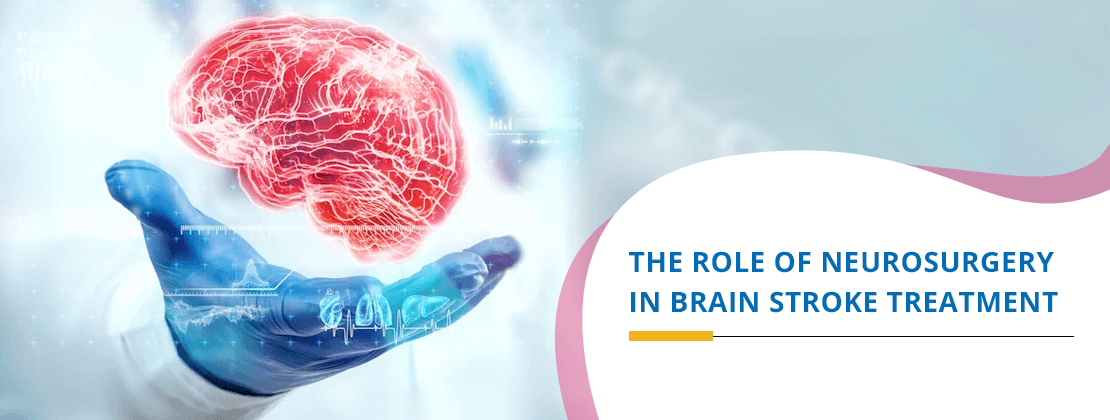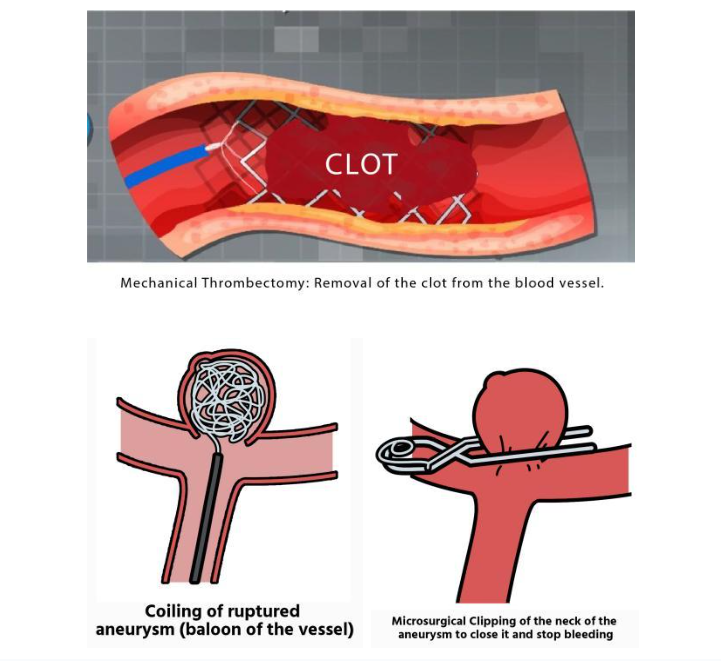
Home / Blog / The Role of Neurosurgery in Brain Stroke Treatment
A Brain stroke is a medical emergency that occurs when the blood supply to the brain is interrupted or reduced. Brain stroke is of two main types: ischemic stroke: caused by a blockage in a blood vessel supplying the brain, and hemorrhagic stroke: caused by a burst blood vessel or a tiny balloon(aneurysm) or nidus (AVM) of vessels in the brain causing brain hemorrhage. Regardless of the type, the impact on the brain can be profound, resulting in long term disability, cognitive impairments or even death and therefore should be treated without delay (ACT FAST).

Several factors contribute to the development of a stroke, and it is crucial to be aware of them to take preventive measures. Lifestyle choices, dietary habits, stress, smoking, and physical inactivity are significant risk factors that can increase the likelihood of experiencing a stroke. Additionally, medical conditions such as high blood pressure, diabetes, and obesity can also increase the risk. Understanding these factors and taking proactive steps to mitigate them are crucial for preventing strokes.
Although stroke is primarily managed by Neurologists, Neurosurgeons have a very important role in stroke management,
Table of Contents
The Recent update in the management of acute stroke involving large blood vessels of the brain is Mechanical Thrombectomy: ischemic strokes, particularly those caused by large blood clots blocking major brain arteries, this procedure can be used for Emergency Removal of the clot. In this procedure (mechanical thrombectomy), we perform a small puncture in the femoral artery in groin, and travel via that to the brain, reach the part of the blood vessels which is blocked by the clot and suck it out to remove the clot via a simple suction aspiration technique or deploy a fishing net type stent to catch the clot (solumbra technique) and then remove it emergently to restart the blood flow in the brain. But this procedure is recommended only upto 18-24 hours maximum, as there is permanent damage to the brain cells after 24-hour period, and the procedure may not yield good results. Therefore, we recommend all patients with Acute stroke to reach tertiary care hospital with a Neurosurgeon and Neurologist without any delay, so that he/she can be saved with this procedure. DON’T IGNORE-ACT FAST.
Patients with large brain hemorrhage, which compresses the brain inside the skull may need Time-tested Emergency Neurosurgery called Decompressive hemicraniectomy (removal of a part of the skull temporarily) to Remove hemorrhage, halt the bleeding and relieve pressure inside brain. This is where neurosurgery can make a life-saving difference.
Recent advancements in Stroke Neurosurgery, like Minimally invasive surgery (MIS): endoscopic/Microscopic removal of the hemorrhage is performed with the idea of minimally damaging the brain tissue and going inside brain via a small hole and are available nowadays at major centres. But these techniques are not for all patients and can be beneficial only for selected cases of hemorrhagic stroke, and are therefore judiciously recommended by neurosurgeons.

Another type of hemorrhagic stroke, subarachnoid hemorrhage, is caused by bleeding into the space between the brain’s surface and the covering layers of brain (meninges). This is usually caused by brain aneurysms, balloon like projections in brain blood vessels, blasting like a timebomb leading to severe bleeding in brain. Neurosurgery can be instrumental in treating this condition as well. Techniques like aneurysm clipping- putting clip at neck of aneurysm and closing it off, via microscopic surgery or endovascular coiling- packing the aneurysm via coils to seal it off via angiographic route (without opening the skull) prevent bleeding again. The surgery is always done by the neurosurgeon under microscope, whereas the later procedure of coiling can be performed by primarily by a Neurosurgeon, but can also be performed by a neurologist or a radiologist trained in neurointervention. Such patients have highest risk of rebleeding in first 24 hours and should be treated urgently without much delay at major hospital by a neurosurgeon.
How to prevent Stroke? Despite the recent advances in neurosurgery, Prevention should always be the goal achieved by understanding and addressing the risk factors that contribute to strokes can significantly reduce their incidence.
Seek Urgent Medical Attention: any warning signs of a stroke, such as sudden weakness or numbness, speech difficulties, or severe headache, seek immediate medical attention. “Time is Brain”- More time you lose more brain is damaged.
The advent of telemedicine has also significantly impacted stroke care. Through telemedicine, neurosurgeons can remotely evaluate and diagnose stroke patients, particularly in rural or underserved areas where access to specialized care may be limited. This early intervention can be critical in guiding patients to appropriate treatment centers, ultimately improving outcomes and reducing the burden of stroke-related disabilities.
In conclusion, understanding the risk factors and making positive lifestyle changes, frequent medical check-ups, we can reduce the risk of stroke. In case of acute stroke, irrespective of the type, one must reach a major hospital with a neurologist and neurosurgeon to get urgent medical treatment. Recent advances in Neurosurgery plays a crucial role in the treatment of strokes, avoiding disability and improving the quality of life and functional independence.
Consultant Neurosurgeon, HCG Hospital, Ahmedabad
Fellow in Stroke and Neurointervention,
Fellow in Cerebrovascular Neurosurgery, PGIMER Chandigarh,
M.Ch Neurosurgery, PGIMER Chandigarh
M.S General surgery (Gold Medallist), MBBS.
Neurosurgery can be crucial for treating brain strokes, especially for removing blood clots in ischemic strokes and relieving brain pressure in hemorrhagic strokes. Techniques include mechanical thrombectomy and decompressive hemicraniectomy.
Neurosurgery helps by removing obstacles (like clots) or reducing pressure inside the brain, which can significantly improve outcomes in stroke patients. Advanced techniques like endoscopic surgery are used depending on the stroke type.
There are mainly two types of strokes that might require surgical intervention: ischemic, where a clot blocks blood flow, and hemorrhagic, where a blood vessel bursts causing bleeding in the brain.
Mechanical thrombectomy is a neuro-interventional procedure used to remove large blood clots from the brain in cases of acute ischemic stroke. It is most effective within 18-24 hours of stroke onset.
Yes, timely neurosurgical interventions can prevent serious complications like prolonged disability or death by efficiently managing the immediate effects of strokes.
Emergency neurosurgical procedures for stroke include decompressive hemicraniectomy for hemorrhagic strokes and mechanical thrombectomy for ischemic strokes.
Lifestyle choices such as diet, exercise, and smoking can significantly influence the risk of stroke. Managing these factors can help reduce the likelihood of this condition.
If stroke is suspected, it’s crucial to act fast and seek immediate medical attention. Symptoms can include sudden numbness, confusion, trouble speaking, and severe headaches.